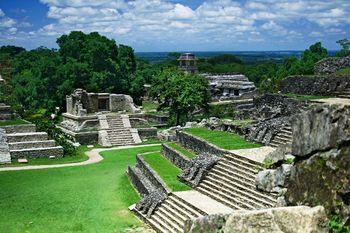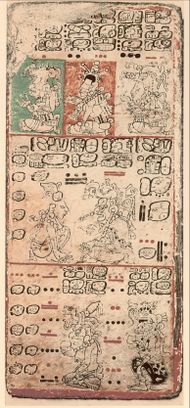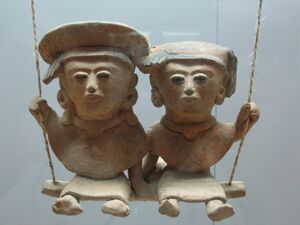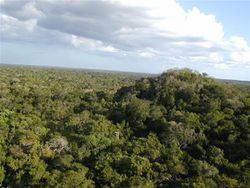وسط أمريكا




وسط أمريكا أو ميزوأمريكا أو ميزو-أمريكا (إسپانية: Mesoamérica) هو مصطلح يُستخدم للدلالة على تاريخ بعض شعوب القارة الأمريكية الوسطى وحضارتهم، وبخاصة المكسيك وگواتيمالا وهندوراس ونيكاراگوا والسلڤادور وكوستاريكا. وهو مصطلح يحمل دلالات تاريخية وحضارية أكثر من دلالته الجغرافية. [1] Mesoamerica was the site of two of the most profound historical transformations in world history: primary urban generation, and the formation of New World cultures out of the long encounters among Indigenous, European, African and Asian cultures.[2]
In the 16th century, Eurasian diseases such as smallpox and measles, which were endemic among the colonists but new to North America, caused the deaths of upwards of 90% of the indigenous people, resulting in great losses to their societies and cultures.[3][4] Mesoamerica is one of the five areas in the world where ancient civilization arose independently, and the second in the Americas. Norte Chico (Caral-Supe) in present-day Peru, arose as an independent civilization in the northern coastal region.


As a cultural area, Mesoamerica is defined by a mosaic of cultural traits developed and shared by its indigenous cultures. Beginning as early as 7000 BCE, the domestication of cacao, maize, beans, tomato, avocado, vanilla, squash and chili, as well as the turkey and dog, resulted in a transition from paleo-Indian hunter-gatherer tribal groupings to the organization of sedentary agricultural villages. In the subsequent Formative period, agriculture and cultural traits such as a complex mythological and religious tradition, a vigesimal numeric system, a complex calendric system, a tradition of ball playing, and a distinct architectural style, were diffused through the area. Also in this period, villages began to become socially stratified and develop into chiefdoms. Large ceremonial centers were built, interconnected by a network of trade routes for the exchange of luxury goods, such as obsidian, jade, cacao, cinnabar, Spondylus shells, hematite, and ceramics. While Mesoamerican civilization knew of the wheel and basic metallurgy, neither of these technologies became culturally important.[5]
Among the earliest complex civilizations was the Olmec culture, which inhabited the Gulf Coast of Mexico and extended inland and southwards across the Isthmus of Tehuantepec. Frequent contact and cultural interchange between the early Olmec and other cultures in Chiapas, Oaxaca and Guatemala laid the basis for the Mesoamerican cultural area. All this was facilitated by considerable regional communications in ancient Mesoamerica, especially along the Pacific coast.
During this formative period distinct religious and symbolic traditions spread, as well as the development of artistic and architectural complexes. In the subsequent Preclassic period, complex urban polities began to develop among the Maya, with the rise of centers such as Aguada fénix and Calakmul in Mexico; El Mirador, and Tikal in Guatemala, and the Zapotec at Monte Albán. During this period, the first true Mesoamerican writing systems were developed in the Epi-Olmec and the Zapotec cultures. The Mesoamerican writing tradition reached its height in the Classic Maya hieroglyphic script.
Mesoamerica is one of only three regions of the world where writing is known to have independently developed (the others being ancient Sumer and China).[6] In Central Mexico, the city of Teotihuacan ascended at the height of the Classic period; it formed a military and commercial empire whose political influence stretched south into the Maya area and northward. Upon the collapse of Teotihuacán around 600 AD, competition between several important political centers in central Mexico, such as Xochicalco and Cholula, ensued. At this time during the Epi-Classic period, the Nahua peoples began moving south into Mesoamerica from the North, and became politically and culturally dominant in central Mexico, as they displaced speakers of Oto-Manguean languages.
During the early post-Classic period, Central Mexico was dominated by the Toltec culture, and Oaxaca by the Mixtec. The lowland Maya area had important centers at Chichén Itzá and Mayapán. Towards the end of the post-Classic period, the Aztecs of Central Mexico built a tributary empire covering most of central Mesoamerica.[7]
The distinct Mesoamerican cultural tradition ended with the Spanish conquest in the 16th century. Over the next centuries, Mesoamerican indigenous cultures were gradually subjected to Spanish colonial rule. Aspects of the Mesoamerican cultural heritage still survive among the indigenous peoples who inhabit Mesoamerica. Many continue to speak their ancestral languages, and maintain many practices harking back to their Mesoamerican roots.[8]



التسمية والتعريف
استخدم هذه التسمية أول مرة المؤرخ پول كيرشوف P.Kirchoff وذلك في أربعينات القرن الماضي؛ لدراسة حضارات صنعتها شعوب مختلفة عرقياً ولغوياً؛ لكن تجمعها قواسم مشتركة سواء في مجالات المعتقدات أم الطقوس أم البناء والعلوم وغيرها.
خلفية تاريخية
دلت الدراسات على أن الإنسان الأول قد وصل إلى القارة الأمريكية قادماً من منطقة شمال شرقي آسيا عبر مضيق بيرنغ Behring منذ نحو 15 ألف سنة خلت؛ عندما كان هذا المضيق أرضاً يابسة ثم تحرك هذا الاستيطان مع مرور الزمن ليشمل في الألف الثامن ق.م مختلف مناطق القارة الأمريكية. وينسب الباحثون إلى هذه المرحلة ما أصبح يُعرف باسم الحضارات الهندية القديمة Paleo-Indian Cultures التي أخذت تسميات مختلفة مثل: كلوڤـيس Clovis وفولسوم Folsom وغيرها من حضارات الصيد والالتقاط.
لكن الحضارة الأقدم والأم التي أتت منها بقية حضارات ميزوأمريكا الزراعية المستقرة والمزدهرة، هي حضارة الأولمك Olmec التي عاشت في المرحلة الواقعة بين 1200-400 ق.م. اشتهرت حضارة الأولمك ببناء المراكز الاحتفالية ceremonial centers التي ضمت المعابد الكبيرة والملاعب والأبنية الإدارية ذات الزخارف والمنحوتات الجميلة والنفيسة مثل معبد سان لورنزو San Lorenzo قرب خليج المكسيك. وهناك فنون النحت الواقعية وغير الواقعية التي دلت عليها تماثيل نصفها بشرية ونصفها الآخر حيواني (نمر) (Were-jaguar)، وهي تشير إلى معتقدات أو آلهة معينة (إله المطر). وقد تركت حضارات الأولمك تأثيرات واضحة في بقية الحضارات الأمريكية اللاحقة وخاصة حضارات وادي واخاكا Oaxaca في المكسيك حيث نشأت أولى المدن الأمريكية الوسطى.
حضارة زاپوتك
الحضارة الميزوأمريكية الثانية هي حضارة زاپوتك Zapotec التي عاشت في المرحلة الكلاسيكية classic الواقعة بين 500 ق.م. ـ 800م، ومن أهم مراكزها موقع مونتى ألبان Monte Alban في المكسيك، وهو مركز احتفالي ضخم قُدّر عدد سكانه بنحو 50 ألف إنسان، بُني فوق تلة صناعية تُشرف على وادي أواكساكا واشتهر بالمعابد الكبيرة مثل معابد إله العاصفة وأرواح الأجداد. وهناك المنحوتات المتميزة وأهمها «الراقصون» Danzantes التي تشير إلى قادة أو آلهة أو غير ذلك. ولهذه الحضارة إنجازات في مجال الفلك ـ التقويم السنوي والعلوم والرياضيات ـ كما تعود إليها أولى الكتابات الهيروغليفية التي وُجدت في القارة الأمريكية. بالتزامن مع هذه الحضارة ظهرت حضارة مدينة تيوتيهواكان Teotihuacan الواقعة في حوض المكسيك والتي تعدّ أكبر موقع معماري وديني وتجاري واقتصادي وإداري وعسكري وأهمه في الحضارات الميزوأمريكية. تجاوز عدد سكانه في القرن الخامس الميلادي الـ 150 ألف نسمة، واحتوى على الأهرامات والمعابد الضخمة لإله الشمس والقمر وتعاصر لبعض الوقت مع موقع آخر هو چولولا Cholula الذي بقي مسكوناً حتى اليوم، وكُشف فيه عن أكبر معبد في أمريكا الوسطى من ذلك العصر.
حضارة ميكستِك
كما تعاصرت حضارة زابوتيك ـ جزئياً ـ مع حضارة ميستك Mixtec التي اشتهرت بأوانيها الفخارية الملونة والرائعة وتماثيلها النصفية الجميلة والمميزة. وقد أدت الصراعات بين الزابوتيك والميكستِك ـ إضافة إلى تردي الظروف المناخية ومن ثم تدهور الأحوال الاقتصادية والسياسية والاجتماعية ـ إلى انهيار هذه الحضارة.
حضارة المايا
وفي زمن معاصر تقريباً ظهرت حضارة كبرى أخرى هي حضارة المايا Maya التي بلغت أوج ازدهارها بين سنة 200ـ850 م، ومثلت قمة إنجازات الحضارات الميزوأمريكية في جميع المجالات المعمارية والفنية والدينية والفلكية.
حضارة التولتك
تلا ذلك ازدهار حضارة التولتك Toltec التي عاشت في المرحلة بعد الكلاسيكية post-classic بين 900ـ1100م، وهي أيضاً إحدى أهم حضارات ميزوأمريكا. كان التولتك محاربين أشداء سيطروا بالقوة على جزء كبير من وسط أمريكا، كما دلت على ذلك المكتشفات التي أتت من عاصمتهم الشهيرة تولا Tula، ويُعتقد أنهم أسلاف حضارة الأزتيك Aztec، وهي الحضارة الميزوأمريكية العظيمة والأخيرة.
جضارة الأزتيك
يعود الأزتيك في أصولهم إلى مجموعة من الشعوب المتنقلة والمحاربة المسماة چيچيمِك Chichimec التي عاشت في حوض المكسيك منذ نحو منتصف القرن الثاني عشر الميلادي. كان الأزتيك محاربين أيضاً فرضوا سيطرتهم على أجزاء واسعة من أمريكا الوسطى، منطلقين من عاصمتهم الشهيرة تنوشتيتلان Tenochtitlan التي نظموها بطريقة فريدة من نوعها؛ إذ قاموا بتجفيف المستنقعات وإنشاء الجزر الصناعية وإقامة شبكة من الأقنية والشوارع الرئيسية والفرعية وتوزيع دقيق للأبنية والأحياء بما في ذلك الأبنية الدينية كالمعبد الكبير الهرمي والمتدرج المخصص لإله المطر والعاصفة، وملاعب الكرة (Ball courts) ذات المضامين الدينية والروحية والتي تعكس ليس فقط معارفهم الكونية المتطورة وغيرها؛ بل سلطتهم السياسية والتجارية الواسعة التي جمعت المنطقة في امبراطورية واحدة، وبقيت قوية حتى أتى الاستعمار الإسباني ليدمر عاصمة المايا ويقضي عام 1522 على هذه الامبراطورية التي جسدت آخر حضارات ميزوأمريكا وأعظمها والتي لازال ورثتها الهنود الحمر يعيشون حتى اليوم.
الجغرافيا
التضاريس
المسطحات المائية
التنوع الحيوي
النطاقات الثقافية الفرعية
الخط الزمني والثقافة
الهندية العتيقة
القديمة
قبل الكلاسيكية/المشكـِّلة
الكلاسيكي
بعد الكلاسيكية
| الفترة | المدى الزمني | المدن والثقافات الهامة |
|---|---|---|
| Paleo-Indian | 10,000–3500 BC | Honduras, Guatemala, Belize, obsidian and pyrite points, Iztapan, |
| Archaic | 3500–1800 BC | Agricultural settlements, Tehuacán |
| Preclassic (Formative) | 2000 BC – 250 AD | Unknown culture in La Blanca and Ujuxte, Monte Alto culture |
| Early Preclassic | 2000–1000 BC | Olmec area: San Lorenzo Tenochtitlan; Central Mexico: Chalcatzingo; Valley of Oaxaca: San José Mogote. The Maya area: Nakbe, Cerros |
| Middle Preclassic | 1000–400 BC | Olmec area: La Venta, Tres Zapotes; Maya area: El Mirador, Izapa, Lamanai, Xunantunich, Naj Tunich, Takalik Abaj, Kaminaljuyú, Uaxactun; Valley of Oaxaca: Monte Albán |
| Late Preclassic | 400 BC – 200 AD | Maya area: Uaxactun, Tikal, Edzná, Cival, San Bartolo, Altar de Sacrificios, Piedras Negras, Ceibal, Rio Azul; Central Mexico: Teotihuacan; Gulf Coast: Epi-Olmec culture; Western Mexico: Shaft Tomb Tradition |
| Classic | 200–900 AD | Classic Maya Centers, Teotihuacan, Zapotec |
| الكلاسيكي المبكر | 200–600 AD | Maya area: Calakmul, Caracol, Chunchucmil, Copán, Naranjo, Palenque, Quiriguá, Tikal, Uaxactun, Yaxha; Central Mexico: Teotihuacan apogee; Zapotec apogee; Western Mexico: Teuchitlan tradition |
| آواخر الكلاسيكي | 600–900 AD | Maya area: Uxmal, Toniná, Cobá, Waka', Pusilhá, Xultún, Dos Pilas, Cancuen, Aguateca; Central Mexico: Xochicalco, Cacaxtla; Gulf Coast: El Tajín and Classic Veracruz culture; Western Mexico: Teuchitlan tradition |
| Terminal Classic | 800–900/1000 AD | Maya area: Puuc sites – Uxmal, Labna, Sayil, Kabah |
| Postclassic | 900–1519 AD | Aztec, Tarascans, Mixtec, Totonac, Pipil, Itzá, Ko'woj, K'iche', Kaqchikel, Poqomam, Mam |
| Early Postclassic | 900–1200 AD | Cholula, Tula, Mitla, El Tajín, Tulum, Topoxte, Kaminaljuyú, Joya de Cerén |
| Late Postclassic | 1200–1519 AD | Tenochtitlan, Cempoala, Tzintzuntzan, Mayapán, Ti'ho, Utatlán, Iximche, Mixco Viejo, Zaculeu |
| Post Conquest | Until 1697 AD | Central Peten: Tayasal, Zacpeten |
الخصائص العامة
المعيشة

العمارة
التنظيم السياسي
الاقتصاد
الخصائص الشائعة في ثقافة وسط أمريكا
نظام التقويم

أنظمة الكتابة

لعبة الكرة

الطب والعلوم
الحساب
الأساطير

القرابين
التضحية بالذات
القرابين البشرية
الفلك
رمزية الفضاء والوقت

الفنون الدينية والسياسية

انظر أيضا
- الشعوب الأصلية في المكسيك
- Indigenous Amerindian genetics
- Middle America (Americas)
- Painting in the Americas before Colonization
هوامش
- ^ سلطان محيسن. "ميزوأمريكا (حضارات ـ)". الموسوعة العربية.
- ^ Davíd Carrasco. "Mesoamerica: An Overview". In Davíd Carrasco (ed). The Oxford Encyclopedia of Mesoamerican Cultures. Vol 2. New York: Oxford University Press, 2001. Pp 212 - 216 ISBN 9780195108156
- ^ "Meso-America," Oxford English Reference Dictionary, 2nd ed. (rev.) 2002. (ISBN 0-19-860652-4) Oxford: Oxford University Press; p. 906.
- ^ (2000): Atlas del México Prehispánico. Revista Arqueología mexicana. Número especial 5. Julio de 2000. Raíces/ Instituto Nacional de Antropología e Historia. México.
- ^ Carmack, Gasco & Gossen 1996, p. 55.
- ^ Brian M. Fagan, ed. (1996). The Oxford Companion to Archaeology. Charlotte Beck. Oxford University Press. p. 762. ISBN 978-0-19-507618-9.
- ^ Carmack, Gasco & Gossen 1996, pp. 40–80.
- ^ Carmack, Gasco & Gossen 1996.
المصادر
- Carmack, Robert M. (1996). Legacy of Mesoamerica, The: History and Culture of a Native American Civilization. New Jersey: Prentice Hall. ISBN 0-13-337445-9.
{{cite book}}: Unknown parameter|coauthors=ignored (|author=suggested) (help)CS1 maint: multiple names: authors list (link) - Coe, Michael D. (1994) [1962]. Mexico: from the Olmecs to the Aztecs (4th edition, Revised and Enlarged ed.). New York: Thames & Hudson. ISBN 0-500-27722-2.
{{cite book}}: CS1 maint: multiple names: authors list (link) - Diehl, Richard A. (2004). The Olmecs: America's First Civilization. London: Thames & Hudson. ISBN 0-500-28503-9.
{{cite book}}: CS1 maint: multiple names: authors list (link) - Diamond, Jared (1999). Guns, Germs and Steel: The Fates of Human Societies. New York: W W Norton & Co. ISBN 0-393-31755-2.
{{cite book}}: CS1 maint: multiple names: authors list (link) - Duverger, Christian (1999). Mesoamérica, arte y antropología.. Paris.: CONACULTA, Landucci Editores. ISBN 970-18-3751-7.
{{cite book}}: CS1 maint: multiple names: authors list (link) (بالإسپانية) - Fernández, Tomás (2003). La escultura prehispánica de mesoamérica. Barcelona: Lunwerg Editores. ISBN 84-9785-012-2.
{{cite book}}: Unknown parameter|coauthors=ignored (|author=suggested) (help)CS1 maint: multiple names: authors list (link) (بالإسپانية) - Filloy Nadal, Laura (2001). "Rubber and Rubber Balls in Mesoamerica". In E. Michael Whittington (Ed.) (ed.). The Sport of Life and Death: The Mesoamerican Ballgame. New York: Thames & Hudson. pp. 20–31. ISBN 0-500-05108-9.
{{cite book}}: CS1 maint: multiple names: authors list (link) - Fuente, Beatrice de la (2001). De Mesoamérica a la Nueva España. Oviedo, Spain: Consejo de Comunidades Asturianas. ISBN 84-505-9611-4.
{{cite book}}: CS1 maint: multiple names: authors list (link) (بالإسپانية) - Gamio, Manuel (1922). La Población del Valle de Teotihuacán: Representativa de las que Habitan las Regiones Rurales del Distrito Federal y de los Estados de Hidalgo, Puebla, México y Tlaxcala (2 vols. in 3 ed.). Mexico City: Talleres Gráficos de la Secretaría de Educación Pública.
{{cite book}}: CS1 maint: multiple names: authors list (link) (بالإسپانية) - Kirchhoff, Paul (1943). "Mesoamérica. Sus Límites Geográficos, Composición Étnica y Caracteres Culturales". Acta Americana. 1 (1): 92–107.
{{cite journal}}: CS1 maint: multiple names: authors list (link) (بالإسپانية) - Kuehne Heyder, Nicola (2001). Mesoamérica: acercamiento a una historia. Granada, Spain.: Diputación Provincial de Granada. ISBN 84-7807-008-7.
{{cite book}}: Unknown parameter|coauthors=ignored (|author=suggested) (help)CS1 maint: multiple names: authors list (link) (بالإسپانية) - Leyenaar, Ted (2001). ""The Modern Ballgames of Sinaloa: a Survival of the Aztec Ullamaliztli"". In E. Michael Whittington (Ed.) (ed.). The Sport of Life and Death: The Mesoamerican Ballgame. New York: Thames & Hudson. pp. 97–115. ISBN 0-500-05108-9.
{{cite book}}: CS1 maint: multiple names: authors list (link) - López Asutin, Alfredo (1996). El pasado indígena. Mexico City: El Colegio de México. ISBN 968-16-4890-0.
{{cite book}}: Unknown parameter|coauthors=ignored (|author=suggested) (help)CS1 maint: multiple names: authors list (link) (بالإسپانية) - Miller, Mary Ellen (2001). El arte de mesoamérica. "Colecciones El mundo del arte". Barcelona.: Ediciones Destino. ISBN 84-233-3095-8..
{{cite book}}: Check|isbn=value: invalid character (help)CS1 maint: multiple names: authors list (link) (بالإسپانية) - O'Brien, Patrick (General Editor) (2005). Oxford Atlas of World History. New York: Oxford University Press.
{{cite book}}:|author=has generic name (help)CS1 maint: multiple names: authors list (link) - Palerm, Ángel (1972). Agricultura y civilización en Mesoamérica. Mexico: Secretaría de Educación Pública. ISBN 968-13-0994-4.
{{cite book}}: CS1 maint: multiple names: authors list (link) (بالإسپانية) - Sahagún, Bernardino de (1950–82) [ca. 1540–85]. Florentine Codex: General History of the Things of New Spain, 13 vols. in 12. vols. I-XII. Charles E. Dibble and Arthur J.O. Anderson (eds., trans., notes and illus.) (translation of Historia General de las Cosas de la Nueva España ed.). Santa Fe, NM and Salt Lake City: School for American Research and the University of Utah Press. ISBN 0-87480-082-X. OCLC 276351.
{{cite book}}: CS1 maint: multiple names: authors list (link) - Taladoire, Eric (2001). "The Architectural Background of the Pre-Hispanic Ballgame". In E. Michael Whittington (Ed.) (ed.). The Sport of Life and Death: The Mesoamerican Ballgame. New York: Thames & Hudson. pp. 97–115. ISBN 0-500-05108-9.
{{cite book}}: CS1 maint: multiple names: authors list (link) - Weaver, Muriel Porter (1993). The Aztecs, Maya, and Their Predecessors: Archaeology of Mesoamerica (3rd ed.). San Diego: Academic Press. ISBN 0-01-263999-0.
{{cite book}}: CS1 maint: multiple names: authors list (link) - West, Robert C. (1989). Middle America: Its Lands and Peoples (3rd ed.). Englewood Cliffs, N.J.: Prentice Hall. ISBN 0-13-582271-8.
{{cite book}}: Unknown parameter|coauthors=ignored (|author=suggested) (help)CS1 maint: multiple names: authors list (link) - Wolf, Eric Robert (1967). Pueblos y culturas de Mesoamérica. Biblioteca Era.
{{cite book}}: CS1 maint: multiple names: authors list (link) (بالإسپانية) - Several Authors (1999). Historia General de Guatemala. ISBN 84-88522-07-4.
{{cite book}}: Check|isbn=value: checksum (help) - This article draws heavily on the corresponding article in the Spanish-language Wikipedia, which was accessed in the version of 29 May 2006. It was translated by the Spanish Translation of the Week collaboration.
وصلات خارجية
- Foundation for the Advancement of Mesoamerican Studies, Inc.
- Maya Culture
- Mesoweb.com – an comprehensive site for Mesoamerican civilizations
- Museum of the Templo Mayor (Mexico) (بالإسپانية)
- National Museum of Anthropology and History (Mexico) (بالإسپانية)
- Selected bibliography concerning war in Mesoamerica (بالإسپانية)
- WAYEB – European Association of Mayanists
- Arqueologia Iberoamericana – Open access international scientific journal devoted to the archaeological study of the American and Iberian peoples. It contains research articles on Mesoamerica.
- Articles containing إسپانية-language text
- Pages using Lang-xx templates
- Articles with hatnote templates targeting a nonexistent page
- CS1 errors: unsupported parameter
- CS1 errors: ISBN
- CS1 errors: generic name
- CS1: abbreviated year range
- ميزوأمريكا
- العصر الكلاسيكي في الأمريكتين
- Pre-Columbian cultural areas
- تاريخ الشعوب الأصلية في أمريكا الشمالية
- الشعوب الأصلية في أمريكا الوسطى
- الشعوب الأصلية في المكسيك
- تاريخ المكسيك
- تاريخ گواتيمالا
- تاريخ بليز
- تاريخ السلفادور
- تاريخ هندوراس
- تاريخ نيكاراجوا









